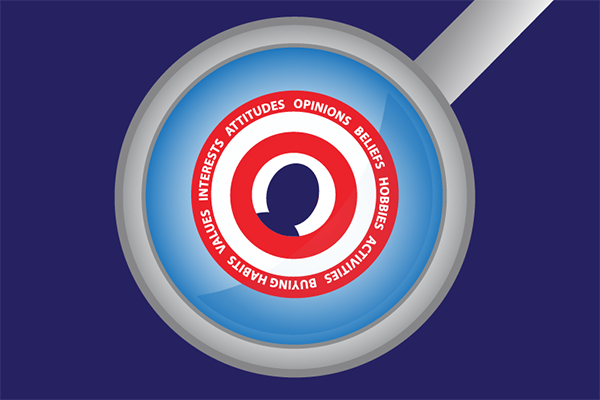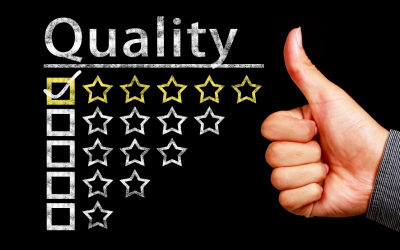Direct marketing thrives on data. Psychographic data is the more qualitative member of the triad of data types that includes demographic and firmographic data, which tend to be quantitative. Demographic data elements include personal attributes. Firmographic data describes organizations. Together they allow marketers to segment their audiences with precision.
Psychographic data uses various inputs to answer why people do, feel, and think what they do. It includes behavioral and attitudinal data that breaks down hard data silos, which can prevent marketers from seeing the best route to a sale. It’s not always a straight line. What seems like an obvious match between offer and target may not be. Perhaps a new target opportunity is going unrecognized. By gaining deeper insights into what makes people tick direct marketers are able to target more effectively.
How Is Psychographic Data Different?
Demographic and firmographic data are readily available in the form of databases compiled from public records. B2C marketers can select data elements like state, zip code, age, gender, and income. Phone numbers and email, and IP addresses may also be available. B2B marketers include UCC filings, executives with titles, company revenue, branches, etc. Modern compiled consumer and business databases are like data buffets: lots of selections and opportunities for segmentation. Take as much as you want.
Psychographic data brings more all-around meaning to the audience targeting process. Most professional marketers consider this a key part of their planning process. Whereas demographic data can tell much about a person, it is comparatively superficial. Psychographic data delves into subjective responses to their personal or professional circumstances. Investigating attitudes, behaviors, and goals in context results in a richer opportunity to develop a relationship.
Where Can Marketers Find Psychographic Data?
Marketing departments can engage with sales teams that are on the front lines, dealing with the spectrum of opportunities from cold calls to longtime customers. Collegial brainstorming backed up by direct experience can lead to actionable behavioral insights.
One way to enhance compiled demographic or firmographic data with psychographic data is via response lists. These are based on what people actually do or buy. This includes media subscriptions, surveys, and merchandise offers. Psychographic value can be gleaned from the interest and intent of specific purchase and response.
Surveys in particular are a good way to extract attitudes and propensities from respondents. Focus groups are also useful, though they require more logistical support. Responses go a long way to establishing whether, and to what extent a person or business is a prospect for products and services.
Company websites can be a rich source of psychographic data. Google Analytics is able to provide attitudinal and behavioral data that shows what does or does not engage visitors. Site owners can segment by interests, understand how visitors find them, and what they do – or don’t do – when they arrive.
If a company has a social media presence, platforms like Facebook provide substantial psychographic data. User interests and attitudes are segmented at the micro level. Get a taste of how granular Facebook targeting can be based on a combination of demographic and psychographic specs.
Compiled databases have begun to supplement the familiar demographic and firmographic details with full ranges of psychographic data points. For example, some previously focused on reaching business executives outside the workplace, may now offer many lifestyle details including buying behavior, financial profile, family makeup, real estate, hobbies, affiliations, and activities. Utilizing this additional perspective can insert marketers deeper into a prospect’s psyche to tailor offers in a way that will resonate.
How Can Psychographic Data Be Used In Marketing?
There are many use cases where combining psychographic data with relevant compiled data elements can produce better performing leads. Here are a few:
Personas – Psychographic data is commonly used to create a buyer persona, sometimes called an Ideal Customer Profile, or ICP. At its best this is a well-rounded profile of a customer or prospect. These profiles have proven useful for scoring current or lapsed customers. They are also used to help build out a mailing list of prospects through look-alike modeling. Psychographic data is able to sharpen focus on what makes a better lead. Demographic, firmographic, and psychographic data combine to help “visualize” target audience members, and inform marketing efforts.
Online>Print – Many of the insights marketers can get from web and social media analytics can be ported to print media. Say a site visitor spends time considering a purchase, navigating options and information. Following up with a relevant brochure or customized promotion makes mailing costly pieces more efficient while providing a more durable brand experience.
Politics – In election seasons, voter rolls within geographical areas are just the beginning. Viable prospects for political fundraising can be inferred from subscriptions to particular news sources. Canvassing interviews, survey results, and organization memberships yield psychographic data that can sharpen outreach to voter/donors ripe for engagement.
Travel & Leisure – Frequent fliers are by association good bets for hotels and car rentals. In times like the present, users of any of these services make a good audience for day trip/staycation offers. Demographic data such as geography, age, and income can be enhanced by context in the form of interests and activities, then further refined to reflect the current health and safety mindset.
Psychographic Data Hits A Moving Target
Psychographic data is fluid, and like the emotions and attitudes it captures, can change quickly. The advantage of monitoring this data is so targeting and messaging can keep up with the target audience’s most current mindset. A segment’s attitudes about a product or service may change, just as the same product or service may find a new audience. Together, enhanced by contemporary analytics, they stand as a powerful triumvirate for marketers.
Psychographic data has taken its place alongside demographic and firmographic data as the building blocks of precise audience targeting. For marketers, psychographic data paints a dynamic picture of attitudes, affinities, emotions, values, and behaviors to forge valuable marketplace connections.




